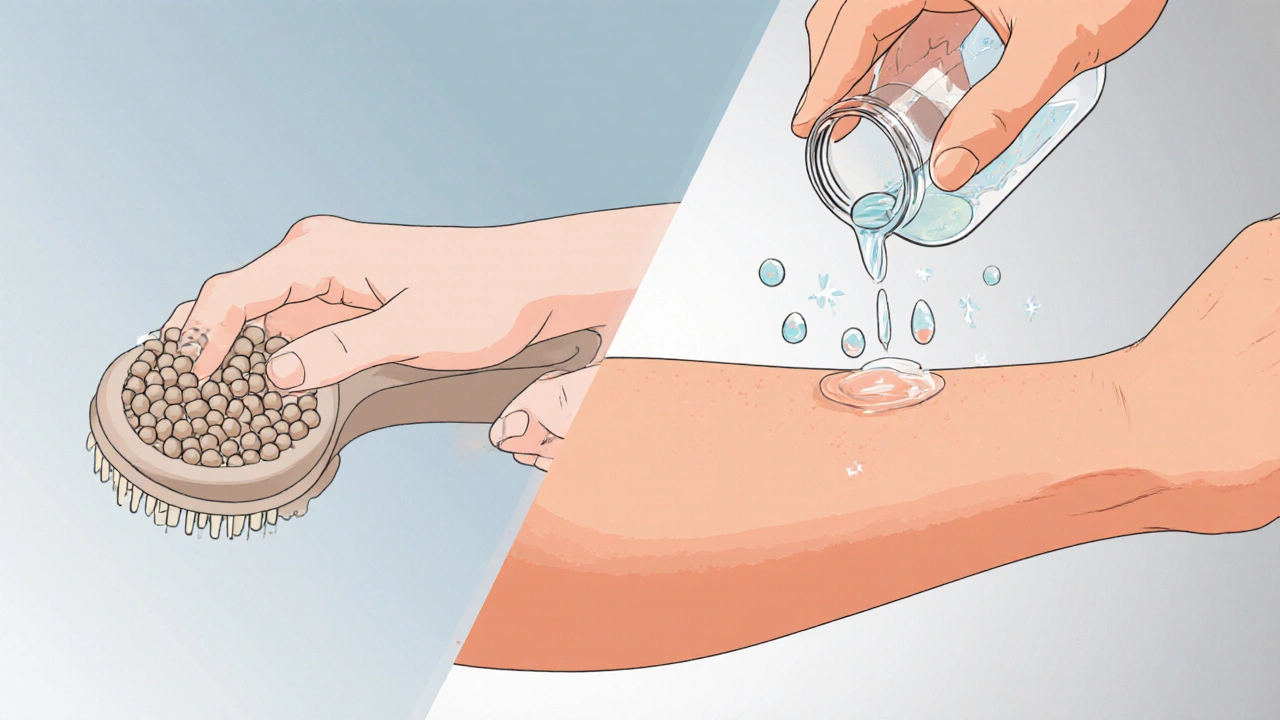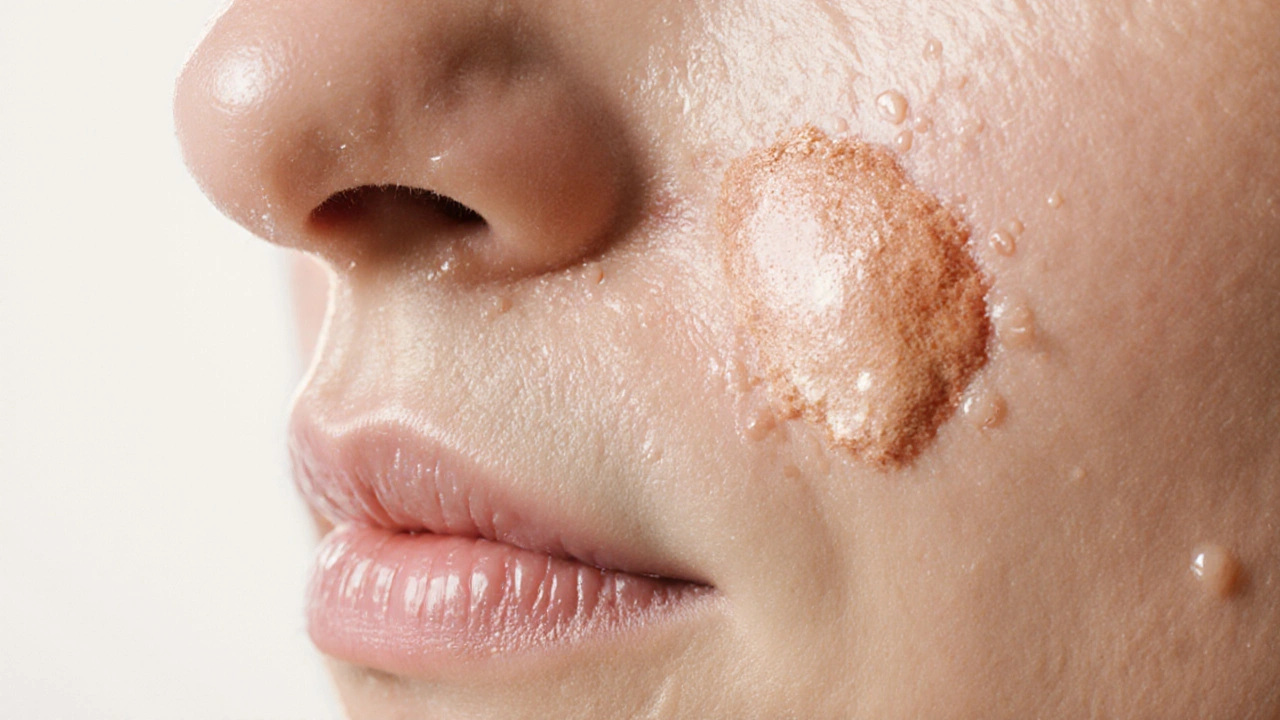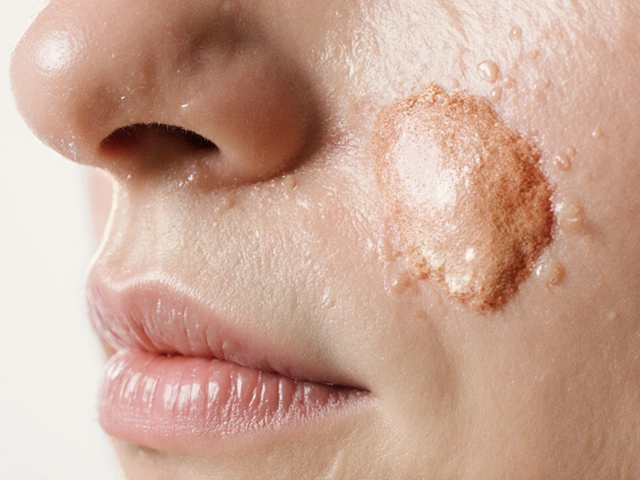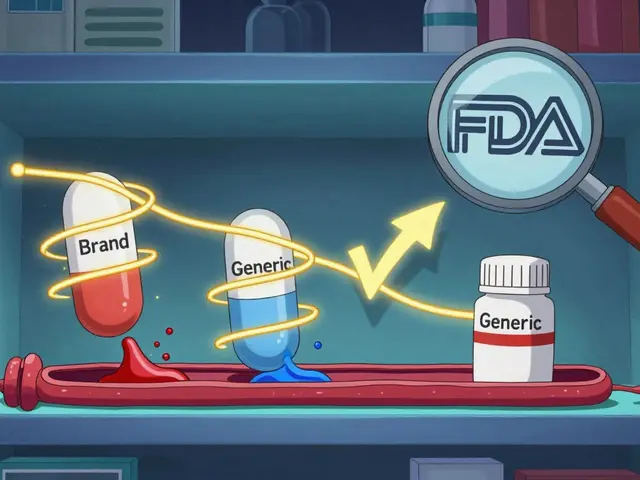Skin Exfoliation Frequency Calculator
Enter your details and click "Calculate Recommended Frequency"
Results are based on dermatological guidelines for safe and effective exfoliation
When it comes to smooth, itch‑free skin, skin exfoliation is a process that removes dead skin cells from the surface, helping to keep the skin barrier healthy and reducing irritation.
Skin itching (pruritus) often stems from clogged pores, dry patches, or an over‑accumulation of dead skin cells that trap irritants.
Key Takeaways
- Exfoliation clears away dead skin cells, preventing the build‑up that triggers itching.
- Both physical and chemical methods work; choose based on skin type and sensitivity.
- Most people benefit from exfoliating 2‑3 times a week, but over‑doing it can damage the skin barrier.
- Look for gentle ingredients like alpha hydroxy acids (AHA) or beta hydroxy acids (BHA) for chemical exfoliation.
- Follow up with a soothing moisturizer to lock in hydration and keep itching at bay.
How Exfoliation Works
The outermost layer of the skin, the stratum corneum, consists of overlapping dead keratinocytes. Over time, these cells can stick together, creating a rough surface that traps sweat, oil, and allergens. Exfoliation gently separates these cells, revealing fresh, living skin underneath.
When the skin barrier stays smooth, it can better regulate moisture and protect against external triggers that cause itching.
Why It Reduces Itching
Itching often starts when irritants get trapped in the dead‑cell layer. By clearing that layer, exfoliation reduces the friction and the micro‑inflammation that makes nerves fire an itch signal. Additionally, smoother skin allows moisturizers to penetrate more effectively, keeping the tissue hydrated-a key factor in itch prevention.
Physical vs. Chemical Exfoliation
| Aspect | Physical Exfoliation | Chemical Exfoliation |
|---|---|---|
| Method | Granular scrubs, brushes, or sponges that mechanically slough off cells | Acid‑based agents (AHA, BHA) that dissolve the bonds between dead cells |
| Ideal Skin Type | Normal to oily skin; not recommended for very sensitive or compromised barriers | All skin types; gentler for sensitive or dry skin when low‑percentage formulas are used |
| Typical Ingredients | Jojoba beads, sugar, salt, silicone‑based polishing particles | Glycolic acid (AHA), lactic acid (AHA), salicylic acid (BHA), enzyme blends |
| Pros | Immediate smoothness, easy to see results | Even exfoliation, can also improve tone and reduce acne |
| Cons | Risk of micro‑tears if too abrasive; can worsen irritation | Potential sting if concentration is high; requires pH‑balanced formulation |

How Often Should You Exfoliate?
Frequency depends on skin type and the exfoliation method:
- Normal to oily skin: 2‑3 times a week with a mild physical scrub or a 5‑10% AHA product.
- Dry or sensitive skin: 1‑2 times a week using a low‑dose BHA (1‑2%) or enzyme mask.
- Active acne or rosacea: Consult a dermatologist; often a once‑weekly gentle chemical exfoliant is safest.
Watch for signs of over‑exfoliation: redness, tightness, or a persistent burning sensation. If any appear, cut back to every 4‑5 days and focus on barrier repair.
Choosing the Right Exfoliant
Look for these clues on the label:
- Alpha hydroxy acids (AHA) - best for surface texture and dryness.
- Beta hydroxy acids (BHA) - penetrate pores, great for oily or acne‑prone skin.
- Enzyme blends (papaya, pineapple) - ultra‑gentle, suitable for very sensitive users.
- Particle size - for physical scrubs, particles should be smaller than 200µm to avoid micro‑abrasions.
Always patch‑test: apply a pea‑size amount on your inner forearm, wait 24hours, and see if irritation develops.
Common Pitfalls & How to Avoid Irritation
- Over‑scrubbing: More friction doesn’t equal better results. Stick to the recommended frequency.
- Using harsh particles: Avoid walnut shells, apricot pits, or large salt crystals; they can create tiny cuts that trigger itching.
- Skipping moisturization: Exfoliation thins the outer layer temporarily; a silk‑rich moisturizer restores lipids and prevents post‑exfoliation itch.
- Mixing actives: Pairing strong acids with retinol or benzoyl peroxide can overwhelm the barrier. Alternate nights or use lower concentrations.
Simple Itch‑Free Routine
- Cleanse with a mild, sulfate‑free wash.
- Apply your chosen exfoliant (see “Choosing the Right Exfoliant”).
- Rinse with lukewarm water; avoid hot showers which strip oils.
- Pat dry and immediately follow with a fragrance‑free moisturizer containing ceramides.
- Finish with sunscreen (SPF30+) if you’re heading outside; UV can worsen post‑exfoliation sensitivity.
Stick to this routine for a few weeks and you should notice less redness, smoother texture, and far fewer itch episodes.
Frequently Asked Questions
Can I exfoliate daily if my skin feels smooth?
Daily exfoliation is rarely necessary and can damage the skin barrier. Most people see optimal results with 2‑3 sessions per week. If you feel you need daily care, opt for a very gentle enzyme mask and always follow with a rich moisturizer.
Is it okay to use a physical scrub right after a chemical peel?
No. Both methods strip the upper layer, and using them together can cause severe irritation and provoke itching. Allow the skin at least 48‑72hours to recover before re‑introducing any exfoliation.
What ingredients should I avoid if I have chronic itching?
Steer clear of fragrances, high‑concentration alcohol, and abrasive particles larger than 150µm. These can aggravate nerve endings and lead to more itching.
Do natural scrubs like coffee grounds work better?
Coffee grounds are relatively coarse and can create micro‑tears, especially on delicate skin. Choose a finely milled, non‑abrasive alternative or switch to a gentle AHA product for a safer itch‑reducing effect.
Can exfoliation help with eczema‑related itching?
For eczema, the focus should be on barrier repair rather than aggressive exfoliation. Very mild enzyme masks may help remove flaky scale, but always consult a dermatologist before adding any exfoliant.







Dominic Ferraro
October 4, 2025 AT 17:24Exfoliating on a regular schedule is like giving your skin a gentle reset every few days.
When you clear away the dead keratin layer, the barrier can breathe and stay hydrated.
That means fewer irritants get trapped, which directly cuts down on those annoying itch spikes.
For most folks with normal to oily skin, two to three sessions a week with a mild AHA works wonders.
If you’re on the drier side, dial it back to once or twice a week and reach for a low‑dose BHA or enzyme mask.
Always follow up with a ceramide‑rich moisturizer; the seal it provides is what locks in the comfort.
Don’t forget to keep the water lukewarm – hot showers strip lipids and can reignite that itchy feeling.
Physical scrubs can feel satisfying, but make sure the particles are fine – think microspheres, not coffee grounds.
Chemical exfoliants, on the other hand, dissolve the bonds between dead cells, offering an even, less abrasive experience.
Typical concentrations of 5‑10% glycolic acid are safe for most, but if you’re new, start at the lower end.
Patch‑testing is essential: a pea‑size dab on your inner forearm for 24 hours tells you if you’re set to go.
Remember, over‑exfoliation shows up as redness, tightness, or a persistent burning sensation – all red flags.
If any of those appear, scale back to once every four to five days and focus on barrier repair.
Sun protection is non‑negotiable after chemical exfoliation; UV rays can amplify sensitivity.
In my experience, combining a gentle exfoliant with a sunscreen SPF 30+ keeps the skin smooth and itch‑free month after month.
Finally, listen to your skin – it will tell you when you’ve found the perfect rhythm.
Jessica Homet
October 9, 2025 AT 08:31Daily scrubs are a recipe for disaster.
Bianca Fernández Rodríguez
October 13, 2025 AT 23:38Honestly, most of these guides overhype AHA’s miracle powers – you can get the same result just by using a gentle wash and a good moisturizer, no need for fancy acids.
Patrick Culliton
October 18, 2025 AT 14:44Stop treating your face like a kitchen sink; you don’t need to scrub it raw to get rid of itching.
Andrea Smith
October 23, 2025 AT 05:51May I commend the author for elucidating the nuanced balance between exfoliation frequency and barrier integrity? It is imperative that readers discern the subtleties of AHA versus BHA applications, particularly in the context of pruritic dermatological conditions.
Gary O'Connor
October 27, 2025 AT 19:58yep, i try a soft scrub once a week and most days i just go with t. that's all i need to keep the itch at bay.
Justin Stanus
November 1, 2025 AT 11:04Exfoliation feels like a fleeting high; you think you’ve solved the itch, then the skin cracks and you’re back to square one.
Claire Mahony
November 6, 2025 AT 02:11While the information is comprehensive, it is essential to stress that over‑reliance on chemical agents without adequate moisturization can exacerbate pruritus, particularly in sensitive populations.
Andrea Jacobsen
November 10, 2025 AT 17:18Great rundown! I’ve found that swapping to a lactic‑acid cleanser twice a week really calms my dry patches and cuts the itch down.
Andrew Irwin
November 15, 2025 AT 08:24I’d add that listening to your own skin’s response is key – if a product feels uncomfortable, pull back and focus on barrier‑supporting ingredients.
Jen R
November 19, 2025 AT 23:31Honestly, this guide covers the basics perfectly – you really only need a gentle exfoliant and a solid moisturizer to keep the itch away.
Joseph Kloss
November 24, 2025 AT 14:38One could argue that the act of exfoliation mirrors the philosophical pursuit of shedding the old self to reveal the true self, yet the practical side warns us against excessive self‑scrubbing.
Anna Cappelletti
November 29, 2025 AT 05:44Exfoliating a couple of times a week with a low‑percentage AHA can really help keep the skin barrier intact, which in turn reduces the itching caused by trapped irritants.
Dylan Mitchell
December 3, 2025 AT 20:51There are several glaring grammatical errors in the table headings – “Physical vs. Chemical Exfoliation” should not be capitalized mid‑sentence; also, “Aspect” is singular while the rows list plurals.
Elizabeth Nicole
December 8, 2025 AT 11:58If you’re chasing an itch‑free glow, start with a simple routine: cleanse, apply a gentle 5% glycolic toner, moisturize, and protect with SPF.
Consistency beats intensity every time.
Track how your skin feels day by day; that data will guide you to the perfect frequency.
Dany Devos
December 13, 2025 AT 03:04From a clinical standpoint, the guide appropriately cautions against frequent abrasive scrubs, which can compromise the stratum corneum and exacerbate pruritus.
Sam Matache
December 17, 2025 AT 18:11This whole exfoliation hype is just marketing fluff – you’ll end up with more irritation if you follow it blindly.
Hardy D6000
December 22, 2025 AT 09:18Let’s be real, America needs to stop worshipping foreign skincare trends and stick to good old‑fashioned moisturizers; all this acid talk is just a fad.
Amelia Liani
December 27, 2025 AT 00:24I truly appreciate the balanced approach presented here; it respects both the science of barrier repair and the lived experience of those battling chronic itch.